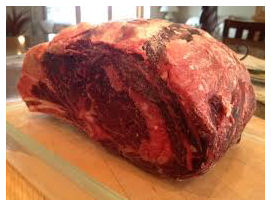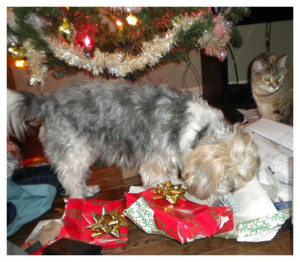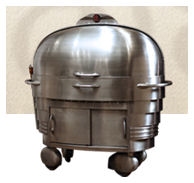(A Prime Rib Primer – Conclusion)

“Twas the Night Before Christmas Dinner and all through the house, not a creature was stirring… (well, except for you) as you sneak downstairs to rub the marinade you made earlier in the day into your now perfectly dry-aged prime rib roast. If it looks a little leathery, try not to worry: everything’s going to be fine.
Marinade for prime rib
(get out the food processor with the metal blade)
6 cloves peeled garlic
2 tablespoons coarse kosher salt
1 ½ tablespoons coarsely ground black pepper
1 heaping tablespoon dried thyme leaves
2 tablespoons roasted fennel seeds (toss in small skillet over high heat ‘til fragrant)
3 tablespoons olive oil
Note: these quantities are for a 5 rib roast – halve them if you really only want a 3 rib…
With the motor running, drop the garlic cloves one by one down the chute. Watch them pulverize and stick to the sides of the bowl. With a rubber spatula, scrape them down and add the olive oil and salt. Run the motor again while pouring the fennel seeds down the chute. Let it run for a minute or so to crush the seeds a bit. Scrape down again, add the pepper and thyme — 3 or 4 1-second pulses and you’re done!
Put in small glass bowl, cover and set aside for later that evening (no need to refrigerate).
Late Christmas Eve, massage the rub into the meat, digging into every little crevice with your fingertips. Tightly wrap in plastic and put back in the fridge.
Early Christmas morning, 2 to 3 hours before cooking, take the roast out, uncover it, place it in a roasting pan, bones down, then let it come to room temperature. No need for a rack — the rib bones do the job naturally. Heat your oven to 200 degrees. It’s perfectly fine to heat it up early (a good idea, in fact).
Go open all the presents, drink some hot chocolate with those little marshmallows and whipped cream, and have a croissant with some homemade jam before cleaning up the wrapping paper mess. Give the cardboard boxes to the dogs to rip, tear and shred (best present of all for them) but be sure to check that there are no loose batteries hiding anywhere — especially the little round ones that can kill a dog easily… btw, tinsel will kill cats if you have them—I hate the look of it, anyway…
A 3-rib roast will take 4 to 6 hours; a 5-rib, 6 to 8 hours; so plan accordingly. Check the temperature with an instant-read thermometer about 30 minutes before the earliest possible finish time. For medium rare, 130 to 135 is good. Personally, I don’t like prime rib too rare – not like a New York strip steak. I like to see a deep pink all the way through, so every slice has a slightly firm consistency—that’s what this slow cooking method creates (no brown around the edges and red in the middle: yuck!)
Tent your beauty with foil and let it rest at least 15 minutes (better 30) in some warm place. If the crust is not brown enough for you, get out one of those torches used for browning the sugar crust of creme brulee. With a slow sweeping motion, flame the surface to make the desired color and crispness. Slice and serve immediately!
 You and your guests will enjoy the closest thing to Lawry’s prime rib this home cook has managed to achieve — after years of trying. And no — I don’t have one of the beautiful silver carts lurking in my basement. Wish I did…
You and your guests will enjoy the closest thing to Lawry’s prime rib this home cook has managed to achieve — after years of trying. And no — I don’t have one of the beautiful silver carts lurking in my basement. Wish I did…
Share this:
Leave a Reply